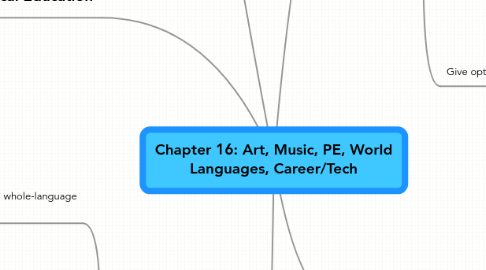
1. World Languages
1.1. Problems with whole-language approach
1.1.1. Rely on
1.1.1.1. good listening
1.1.1.2. phonemic awareness
1.1.1.3. auditory discrimination
1.1.2. Areas of difficulty for students with disabilities
1.2. Adapted procedures
1.2.1. Focus on phonemic patterns
1.2.1.1. explicitly teach sounds
1.2.1.2. Connect with orthography
1.2.1.2.1. spelling patterns of language
1.3. General adaptations
1.3.1. preferential seating
1.3.2. recording lectures
1.3.3. Give copies of notes
1.3.4. Enough practice and feedback
1.3.5. Adapt tests
1.4. Vocabulary
1.4.1. Mnemonic strategies
1.4.2. Keep note cards
1.4.3. Peer tutoring to practice
1.4.4. Continuous review of old words
1.5. Media
1.5.1. audio files
1.5.2. computer programs
1.5.2.1. allow students to record and listen to own voice
2. Music
2.1. Determine goals
2.1.1. Meet with special ed teacher
2.1.2. Allow enough time and practice
2.2. Physical adaptations
2.2.1. Grips for instruments
2.2.2. Larger tools
2.2.3. Secure instruments to floor or desk
2.3. Modify for special needs
2.3.1. Options instead of vocalizing
2.3.1.1. Tapping with hands or feet
2.3.1.2. Blinking eyes
2.3.2. Options instead of hearing
2.3.2.1. Feel vibrations
2.3.3. Options for visual impairments
2.3.3.1. Braille
2.3.3.2. Large print
2.3.3.3. Recorded music
2.4. Reading/memorizing tasks
2.4.1. Reduce reading required
2.4.2. Use mnemonics
2.5. Recognize talents
2.5.1. Perform in bands or choirs
3. Physical Education
3.1. Options for mobility
3.1.1. Develop motor skills
3.1.2. Communicate with nurse/therapist
3.1.3. Modify endurance required
3.1.3.1. Shorten distances
3.1.3.2. Decrease points to win
3.1.3.3. Allow balls to bounce/be held
3.1.4. Adapt equipment
3.1.4.1. Larger ball
3.1.4.2. Use aids for practicing
3.1.4.2.1. Tees for baseball
3.1.4.2.2. backstops
3.1.4.3. Velcro
3.2. Peer interactions
3.2.1. Buddy system
3.2.1.1. shoulder taps for hearing impaired
3.2.1.2. Describe action for vision impaired
3.2.2. Avoid having captain-selected teams
3.3. Options for representation
3.3.1. For hearing impairments
3.3.1.1. Line of vision
3.3.1.2. Demonstrate, not explain
3.3.1.3. Stand close
3.3.1.4. Use cues for listening
3.3.2. For visual impairments
3.3.2.1. Add sound to orient
3.3.2.2. Use guide rails
3.3.2.3. Describe clearly
3.3.3. Break into steps
3.4. Options for responding
3.4.1. Set appropriate goals
3.4.2. Work on part or whole skill
3.4.3. Allow practice and review
3.4.4. Modify tests
3.5. Recognize talent
3.5.1. Refer to adapted sports teams
4. Art
4.1. Adapted equipment for motor difficulties
4.1.1. special grips
4.1.2. larger paper
4.1.3. larger brushes/crayons
4.2. Focus on motor skills
4.2.1. Model fine and gross motor skills
4.2.2. Allow students to practice
4.3. Be safe
4.3.1. Establish rules for using materials
4.3.2. Enforce safe methods for handling scissors, etc.
4.3.3. Give students jobs for cleaning up
4.4. Prepare environment
4.4.1. Protect surfaces with plastic
4.4.2. Have students wear smocks
4.4.3. Store materials where they are accessible
4.5. Create partnerships among peers
4.5.1. Peer to help gather materials
4.5.2. Peer to remind about steps
4.6. Monitor pace of activities and instruction
4.6.1. time to acquire new concepts
4.6.2. time to break down steps (task analysis)
4.6.3. time for additional practice of skills
4.6.4. time to build toward more complexity
4.7. Give options
4.7.1. media
4.7.1.1. computer
4.7.1.2. crayon, sponge, etc.
4.7.2. examples
4.7.2.1. diverse artists
4.7.3. further study
4.7.3.1. advanced classes
4.7.4. connections to other subjects
5. Career/Technical Ed
5.1. Purpose
5.1.1. Prepare for employment
5.1.2. agriculture
5.1.3. business
5.1.4. family and consumer sciences
5.1.5. marketing
5.1.6. health
5.1.7. trade/industry
5.1.8. technical/communications
5.2. Perkins Act, 1984
5.2.1. states required to meet needs of people with disabilities, et al.
5.2.2. equal access
5.2.3. LRE
5.2.4. funds
5.3. Modifications
5.3.1. Prioritize objectives
5.3.2. Physically accessible
5.3.3. Plan for safety
5.3.4. Adapt reading materials
5.3.5. Procedural instruction
5.3.6. Time on task with teacher or tutor
5.4. Generalizable skills
5.4.1. Math
5.4.2. Communications
5.4.3. Interpersonal skills
5.4.4. Reasoning skills
